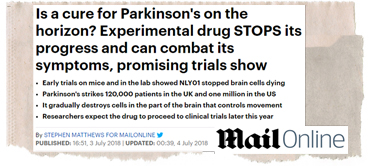Click the play button for the audio version of this Research Summary
NLY01 and a-synuclein reduction

Astrocyte activation blocked by antidiabetic drugs – evidence for neuroprotective effects
The takeaway
Why is it important?
%
IMPACT
- Novelty 80%
- Proximity 70%
- Deliverability 70%
Impact Opinion
Background
The build-up of aggregates of the protein alpha synuclein is a hallmark of Parkinson’s, and injecting it in the form of toxic, preformed fibrils into brain regions central to movement, such as the striatum, was shown to cause problems with movement 3-6 months later in an animal model.
Having established a valid animal model, the researchers sought to understand what effect the antidiabetic GLP1 receptor agonist NLY01 has on neuronal survival. A month after injecting the harmful alpha synuclein fibrils, NLY01 was administered twice weekly for 5 months.
NLY01 treatment significantly reduced alpha synuclein build up, promoted dopamine neuron survival and improved movement in the animals that had been treated with the drug compared to those who were not.
The details
But how did NLY01 confer these effects? NLY01 did not promote dopamine neuron survival when applied to a cell culture of dopamine neurons alone. Moreover, injecting alpha synuclein fibrils into brain tissue containing both neurons and non-neuronal cells which include microglia and astrocytes, increased levels of the GLP1 receptor in these non-neuronal cells. These findings shift the focus directly onto microglia and astrocytes.
What are microglia and astrocytes? Both are glial cells, which are as abundant in the brain as neurons. Microglia are the first line of immune defense for the brain, clearing noxious substances and through inflammatory substances they secrete (called cytokines) also trigger astrocytes into a reactive state so that they too can effectively fight off infection. This process however can also kill neurons.
The researchers found that alpha synuclein fibrils activated microglia, but what effect did NLY01 have on them? Normally, activated microglia begin to pump out cytokines aimed at activating astrocytes. The researchers collected the solution in which the microglia were grown and applied it to astrocytes. They found that the solution that came from the NLY01 treated microglia did not trigger astrocyte reactivity, which in turn promoted dopamine neuron survival.



